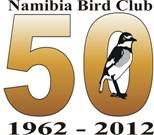![]() SABAP2 is launched at the Namibia Bird Club symposium
SABAP2 is launched at the Namibia Bird Club symposium
[Namibian
-- May 2012]
 The
Namibia Bird Club celebrated its' 50th year of activities with a symposium
emphasizing the value of monitoring southern African bird species. The
celebration both reflected on past ornithological milestones and offered
the most important monitoring activity for the future – formal involvement
by Namibia in SABAP 2. SABAP is the acronym for Southern African Bird
Atlassing Project and SABAP 2, the second of its kind in southern Africa,
is administered by the Animal Demographic Unit at the University of Cape
Town. The project has been ongoing in South Africa since 2005. The launch
in Namibia in 2012 has a guaranteed success because of a dedicated group
of Namibian citizen scientists, many of whom were participants at the
Namibia Bird Club symposium.
The
Namibia Bird Club celebrated its' 50th year of activities with a symposium
emphasizing the value of monitoring southern African bird species. The
celebration both reflected on past ornithological milestones and offered
the most important monitoring activity for the future – formal involvement
by Namibia in SABAP 2. SABAP is the acronym for Southern African Bird
Atlassing Project and SABAP 2, the second of its kind in southern Africa,
is administered by the Animal Demographic Unit at the University of Cape
Town. The project has been ongoing in South Africa since 2005. The launch
in Namibia in 2012 has a guaranteed success because of a dedicated group
of Namibian citizen scientists, many of whom were participants at the
Namibia Bird Club symposium.
After a brief introduction and welcome to foreign dignitaries from Gudrun Mittendorf the current chairperson of the club, Holger Kolberg, the ornithologist from the Ministry of Environment and Tourism provided an overview of the past 50 years of birding in Namibia including historical photos of the first bird ringing events 50 years ago. This was followed by two days of excellent presentations showcasing ornithological research from Namibia, Botswana and South Africa which led the symposium's participants to a most important reason for bird watching - monitoring to reveal changes in distribution and population sizes in a time of global climate change, urbanization and industrialization.
From Botswana and representing Birdlife Botswana at the symposium, Peter Hancock emphasized the importance of collaborative monitoring, research and information sharing because birds do not see national boundaries and Namibia and Botswana share over 450 species. Particular emphasis was given to those species known to be facing serious challenges to their future existence. Importantly this presentation also emphasized people from two perspectives, providing information and recreational opportunities to people and using the public, the citizen scientists, to contribute to monitoring bird species.
Not only was the Namibia Bird Club's 50th celebration graced by Birdlife Botswana but also by the CEO of Birdlife South Africa, Mark Anderson. The presentation from Birdlife South Africa focussed on the Lesser Flamingo. This species, important to Namibia's tourism, has only three breeding sites throughout it's range and all these sites are under some form of threat. From this presentation, which described a project in Kimberley, South Africa that received large funds from a local mining industry to mitigate threats to flamingo breeding success, lessons learnt can be used to guide Namibia with future conservation projects.
One presentation that provided positive encouragement for mitigation measures in conservation was given by John Paterson, the project manager of the Namibian arm of the Albatross Task Force. This global project focusses on the decline of pelagic birds especially albatross and petrel species. The root cause of this decline is attributed to the birds being unintentional by-catch of the fishing industry where over 300 000 birds are reported as annual victims. Although much advocacy work still needs to be done, mitigation measures have dramatically reduced this by-catch number among the Namibian and South African fishing fleets.
The Namibia Bird
Club symposium was followed by a weekend of bird ringing. Birds species
and any changes recorded in the territories that they occupy or in their
population sizes are important indicators to environmentalists and agriculturalists
in our fast changing world. The birds can provide timely alerts to developing
issues. Person's interested in following or joining the activities of
the Namibia Bird Club can find details on their webpage www.namibiabirdclub.org
or simply like and join them on facebook.
 Liz
Komen
Liz
Komen
NARREC